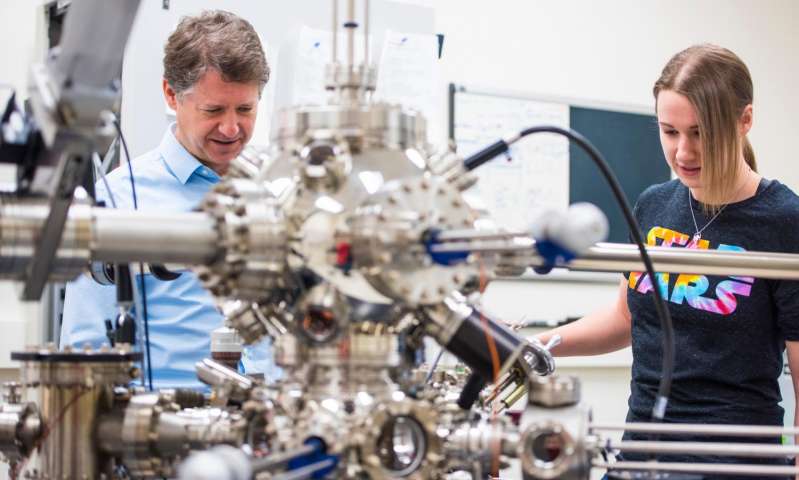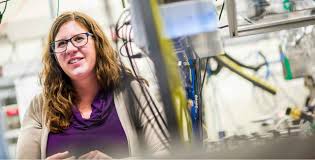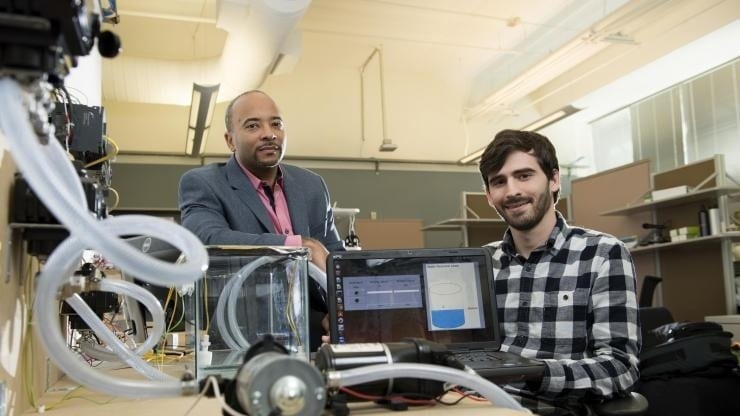
Read more at: https://phys.org/news/2017-02-ultimate-green-technology-energy.html#jCp
Imagine patterning and visualizing silicon at the atomic level, something which, if done successfully, will revolutionize the quantum and classical computing industry. A team of scientists in Edmonton, Canada has done just that, led by a world-renowned physicist and his up-and-coming protégé.
University of Alberta PhD student Taleana Huff teamed up with her supervisor Robert Wolkow to channel a technique called atomic force microscopy—or AFM—to pattern and image electronic circuits at the atomic level. This is the first time the powerful technique has been applied to atom-scale fabrication and imaging of a silicon surface, notoriously difficult because the act of applying the technique risks damaging the silicon. However, the reward is worth the risk, because this level of control could stimulate the revolution of the technology industry.
“It’s kind of like braille,” explains Huff. “You bring the atomically sharp tip really close to the sample surface to simply feel the atoms by using the forces that naturally exist among all materials.”
One of the problems with working at the atomic scale is the risk of perturbing the thing you are measuring by the act of measuring it. Huff, Wolkow, and their research collaborators have largely overcome those problems and as a result can now build by moving individual atoms around: most importantly, those atomically defined structures result in a new level of control over single electrons.
This is the first time that the powerful AFM technique has been shown to see not only the silicon atoms but also the electronic bonds between those atoms. Central to the technique is a powerful new computational approach that analyzes and verifies the identity of the atoms and bonds seen in the images. “We couldn’t have performed these new and demanding computations without the support of Compute Canada. This combined computation and measurement approach succeeds in creating a foundation for a whole new generation of both classical and quantum computing architectures,” says Wolkow.
He has his long-term sights set on making ultra-fast and ultra-low-power silicon-based circuits, potentially consuming ten thousand times less power than what is on the market.
Learn more: The ultimate green technology: Creating computers that use 10,000 times less energy
[osd_subscribe categories=’electronic-circuits’ placeholder=’Email Address’ button_text=’Subscribe Now for any new posts on the topic “ELECTRONIC CIRCUITS”‘]
Receive an email update when we add a new ELECTRONIC CIRCUITS article.
The Latest on: Electronic circuits
[google_news title=”” keyword=”electronic circuits” num_posts=”10″ blurb_length=”0″ show_thumb=”left”]
via Google News
The Latest on: Electronic circuits
- Researchers create a new circuit board material that can be easily recycledon April 30, 2024 at 10:32 am
Researchers at the University of Washington have announced the development of a new type of PCB with significantly higher recycling potential than traditional printed circuits. Utilizing ...
- HQ NextPCB of HQ Electronics Debut on the International Stage for Electronics Manufacture at IPC APEX 2024on April 30, 2024 at 5:34 am
HQ NextPCB of HQ Electronics, a leading Chinese-based multilayer PCB manufacturer and assembly house showcased its industrial prowess on the international stage for the first time at the IPC APEX Expo ...
- Power Management Integrated Circuit Market is Poised to Reach USD 54.69 Billion By 2032: Astute Analyticaon April 30, 2024 at 1:30 am
Beyond Consumer Electronics: Diversifying PMIC Applications The power management integrated circuit market extends far beyond consumer electronics. The automotive sector, driven by the increasing ...
- Almost 100%-recyclable circuit board turns to jelly for disassemblyon April 29, 2024 at 2:24 pm
A new type of printed circuit board (PCB) could drastically reduce the amount of electronic waste that ends up in landfills. Although most PCBs are difficult to recycle, such is not the case with this ...
- Intervala Selects Westmoreland County Community College as Electronics Technician Training Partneron April 29, 2024 at 11:28 am
WESTMORELAND COUNTY, PA – Intervala, a premier full-service electronics manufacturing services provider, and Westmoreland County Community College (Westmoreland), an accredited public community ...
- The science of recycling printed circuit boardson April 29, 2024 at 10:00 am
A team of researchers at the University of Washington developed a new printed circuit board material that works as well as traditional types and can be dissolved into a jelly-like ...
- 'F1 24' Shows Off Updated Circuits, 2024 Season F1 Cars And More In 13 Mins Of Gameplay - Traileron April 29, 2024 at 9:14 am
F1 24 players can expect a fully overhauled Career mode, new EA Sports Dynamic Handling System, and so much more.
- Circuit Materials Market Poised for Growth: US$ 58 Billion by 2033 Fueled by Electric Vehicleson April 29, 2024 at 2:42 am
In 2022, the circuit materials market reached a value of US$ 36.7 billion. In 2023, the market for superconductors is expected to reach more than US$ 38.6 billion. The forecast term is expected to see ...
- New circuit boards can be repeatedly recycledon April 26, 2024 at 9:19 am
A recent United Nations report found that the world generated 137 billion pounds of electronic waste in 2022, an 82% increase from 2010. Yet less than a quarter of 2022's e-waste was recycled. While ...
via Bing News










